Abstract
A large number of organisms such as viruses, protozoa, helminths, fungi and bacteria, especially mycobacteria, need cell-mediated immunological processes for their elimination. As well as being involved in protection, cell-mediated immunological processes are also involved in a number of allergic reactions to products derived from mycobacteria. Cell-mediated immunological processes can be demonstrated by a number of in vitro reactions. Leprosy can present with a wide range of different clinical patterns. The clinical spectrum of leprosy can be shown to depend on the degree of the cell-mediated immune response of the host against Mycobacterium leprae. Thus in tuberculoid leprosy there is a high degree of cell-mediated immune response whereas in lepromatous leprosy such a response is virtually absent. There appears to be a constitutional predisposition to lepromatous leprosy. In addition to a specific loss of cell-mediated immune response against Myco. leprae, there is also a non-specific drop in the ability of patients with lepromatous leprosy to show other aspects of cell-mediated immune response, e.g., contact sensitivity and skin homograft rejection. There is also a relative impairment of the ability of lymphocytes to react in vitro. Lymph nodes from patients with lepromatous leprosy show a deficiency in those areas associated with the development of cell-mediated immune responses.
The article includes a discussion on the possible causes of deficiencies in cell-mediated immune responses in lepromatous leprosy.
Full text
PDF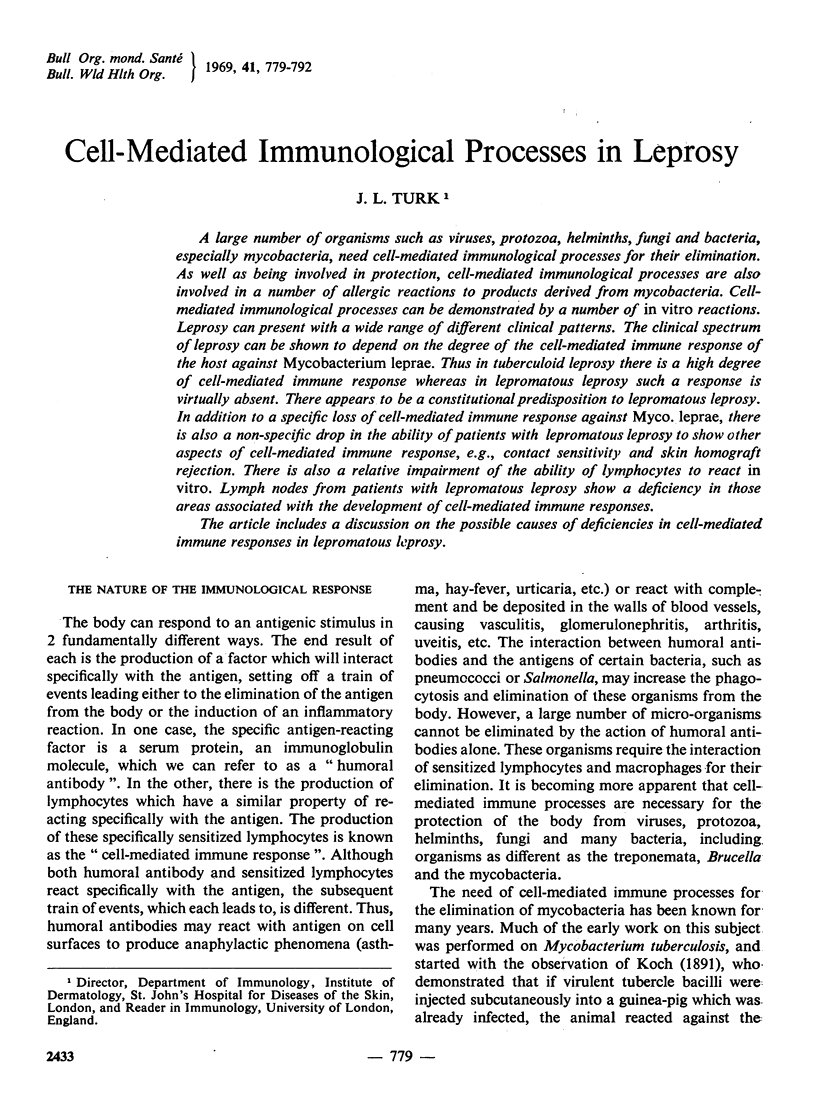
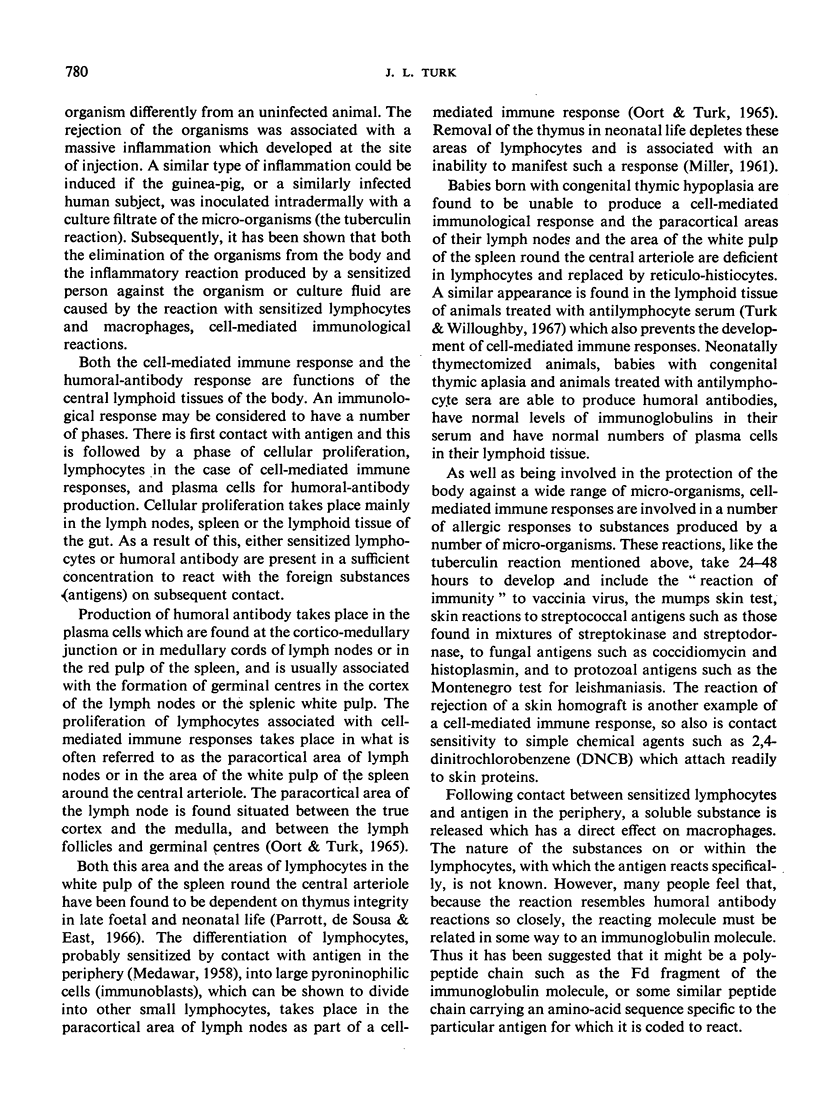
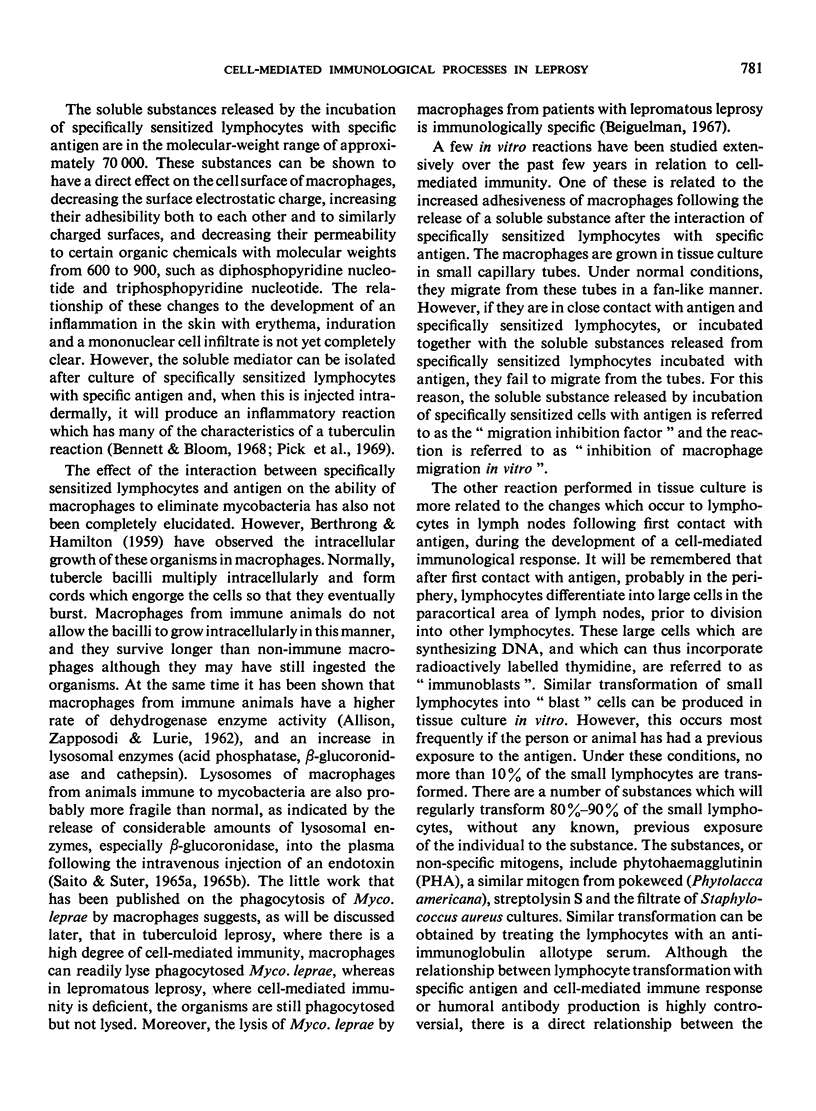
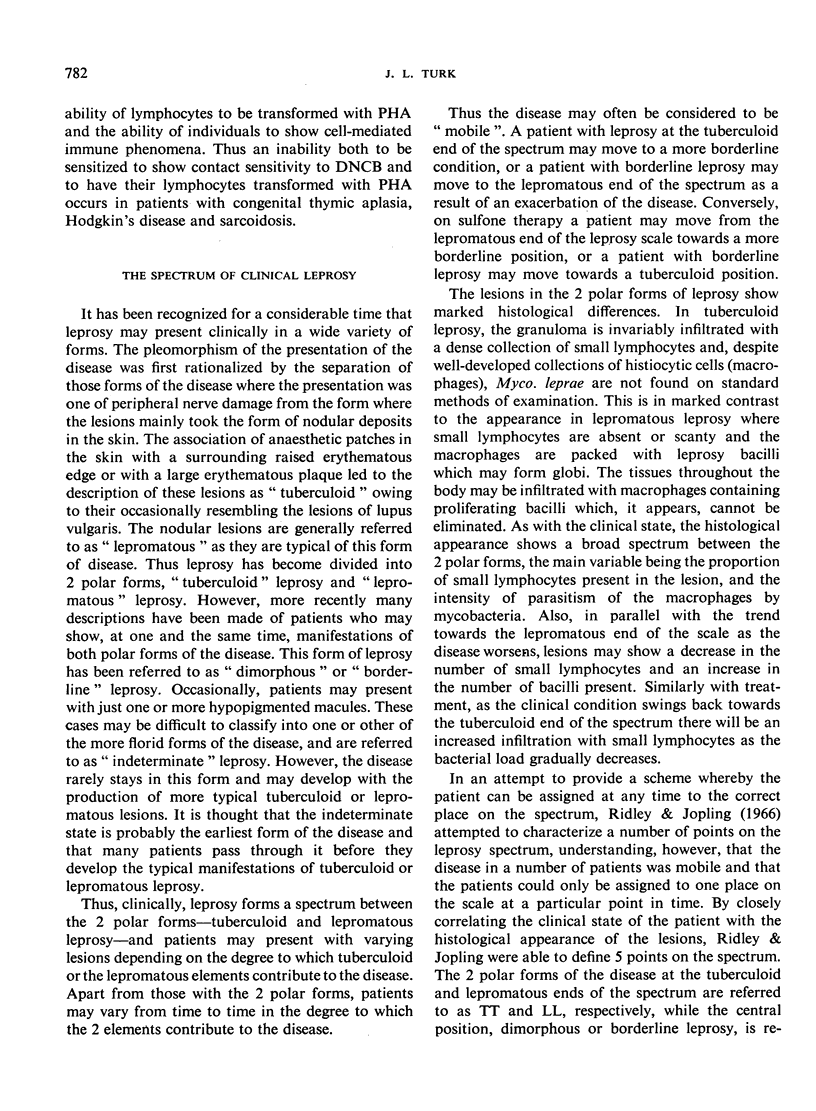

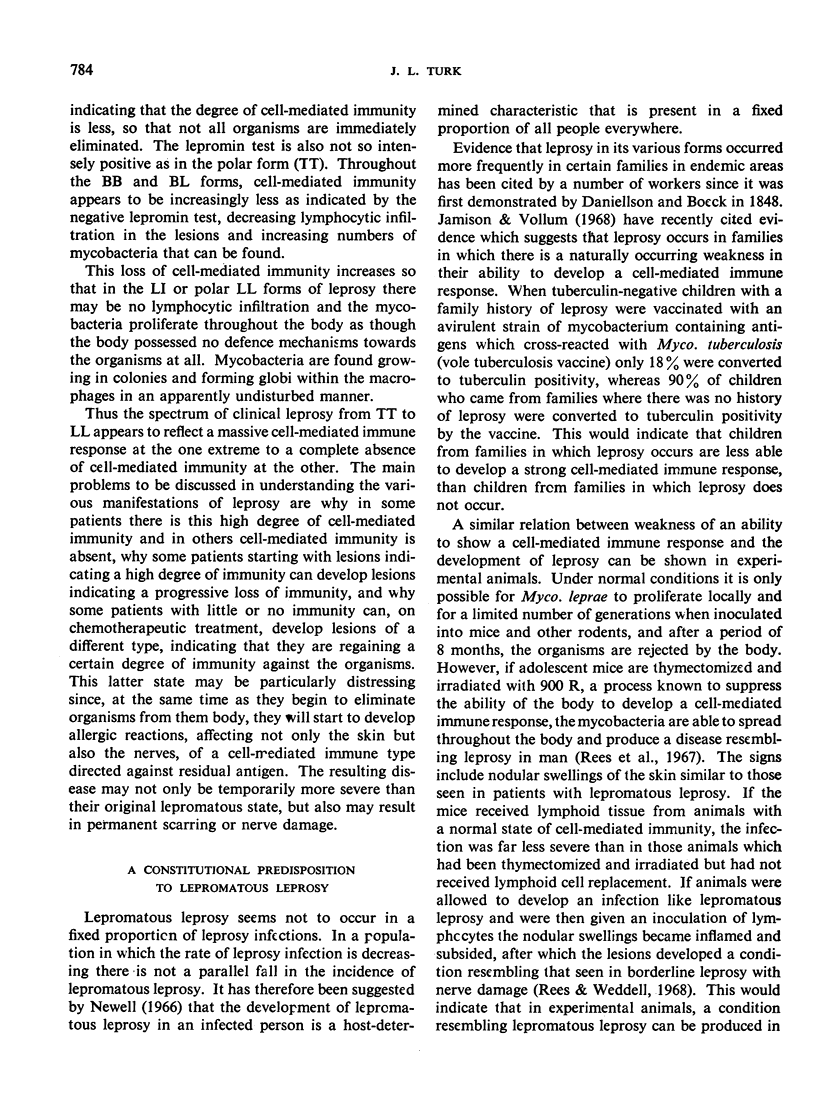
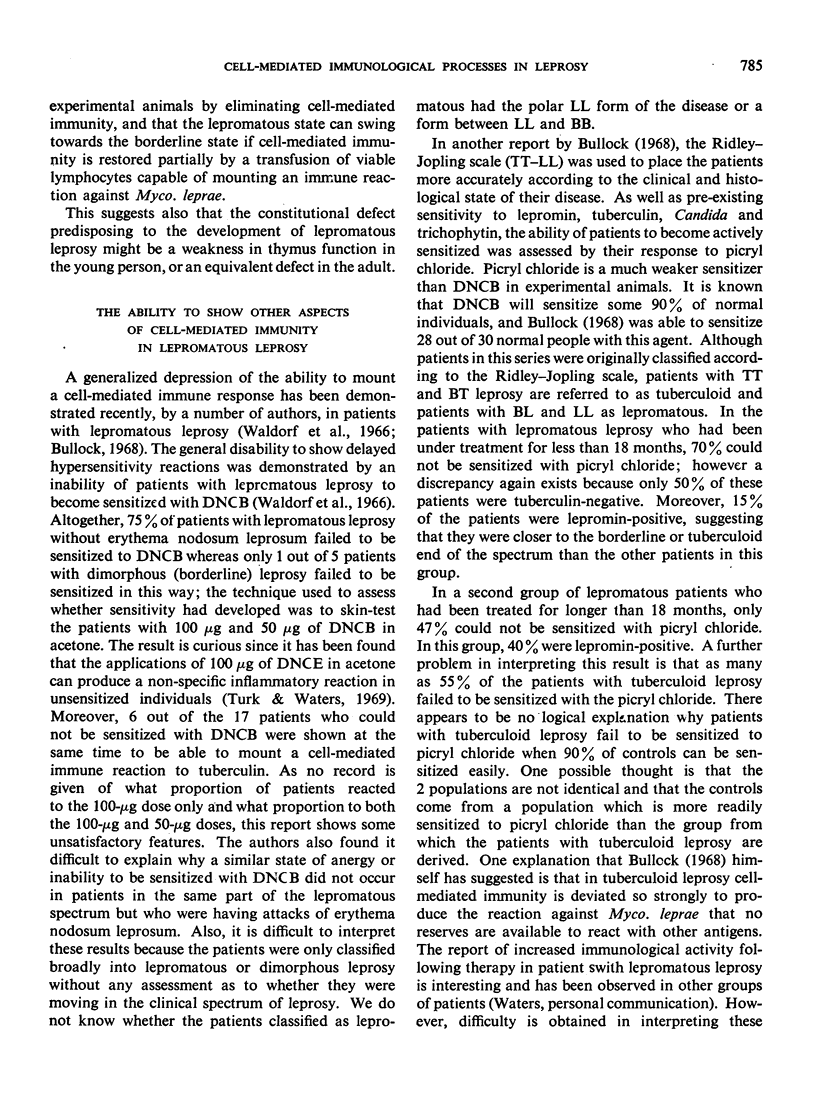
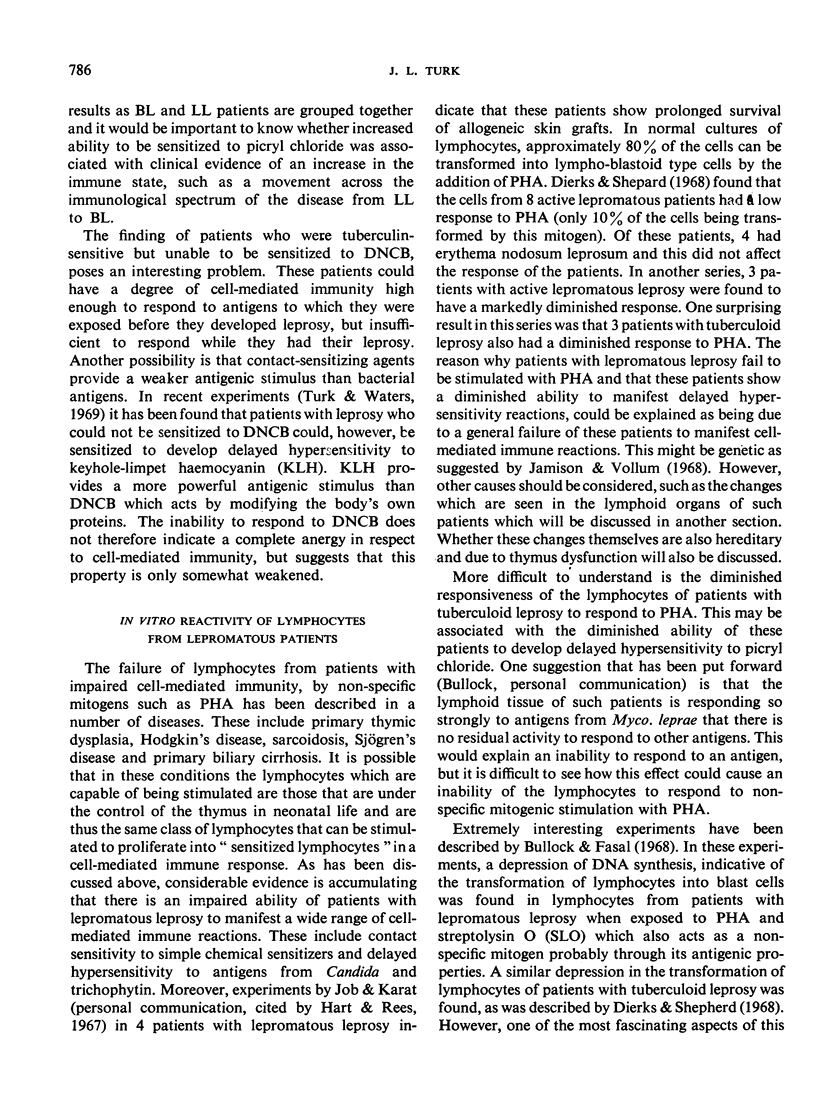
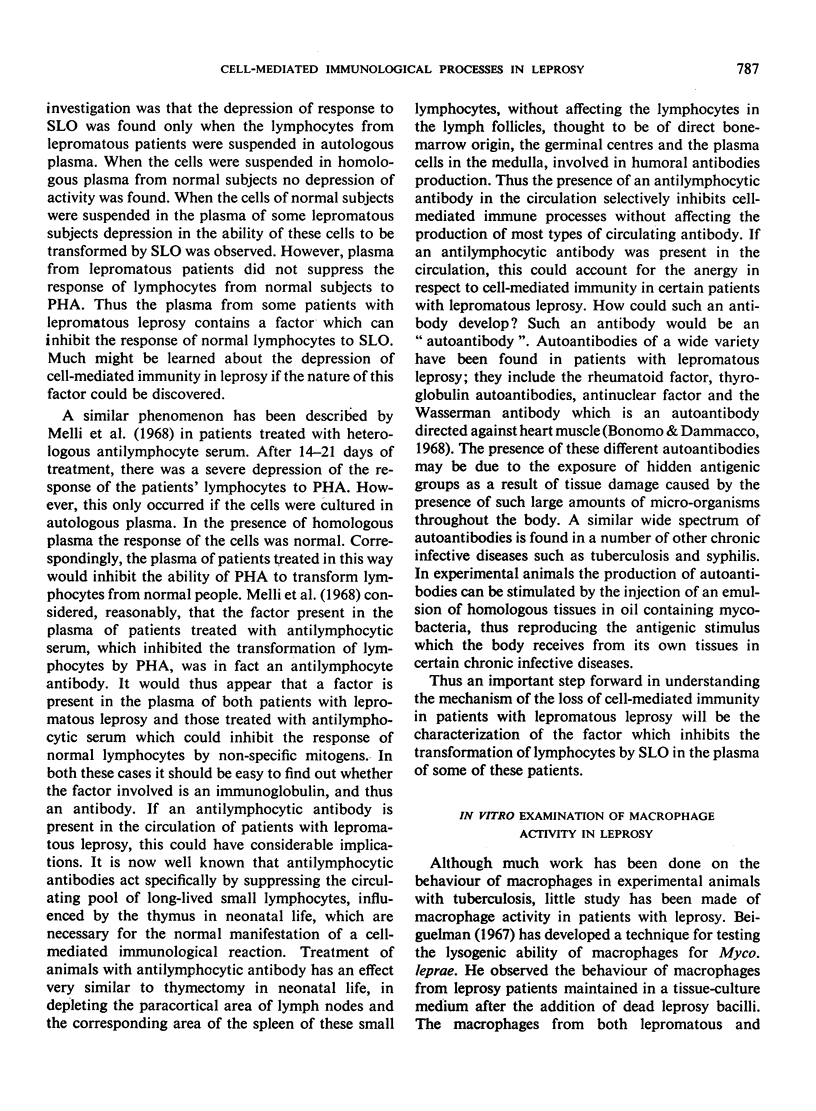
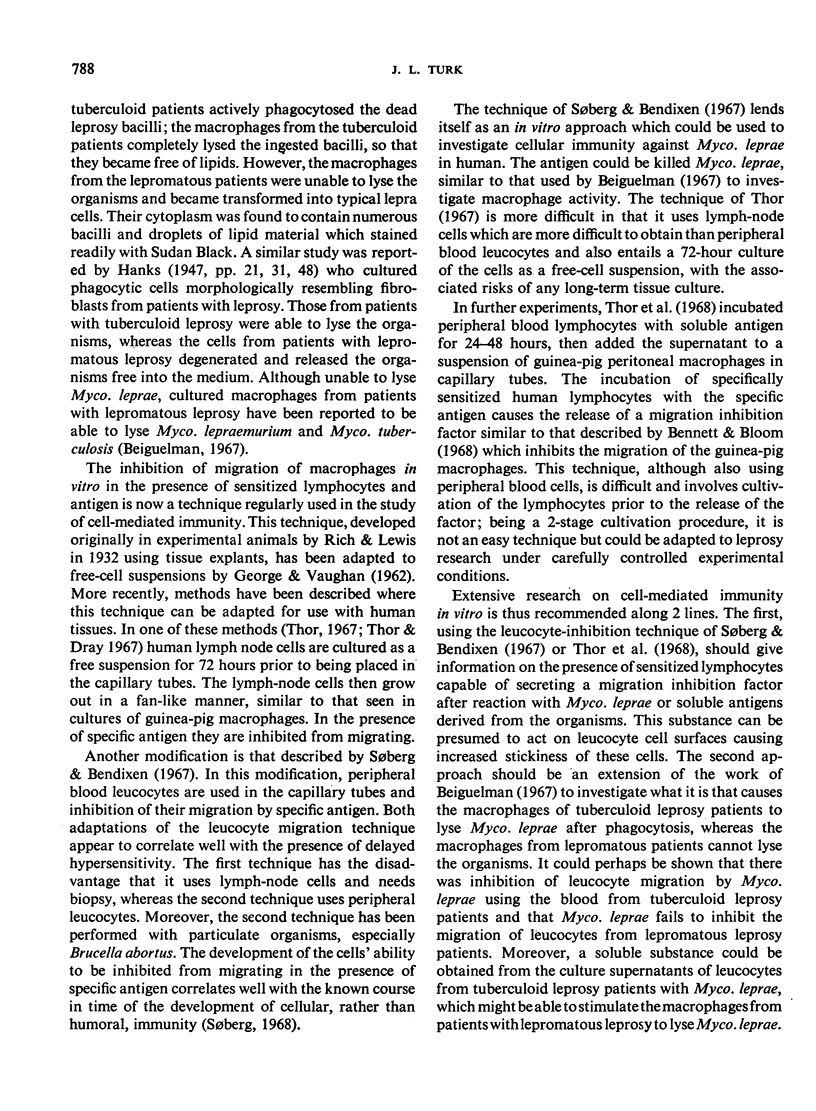
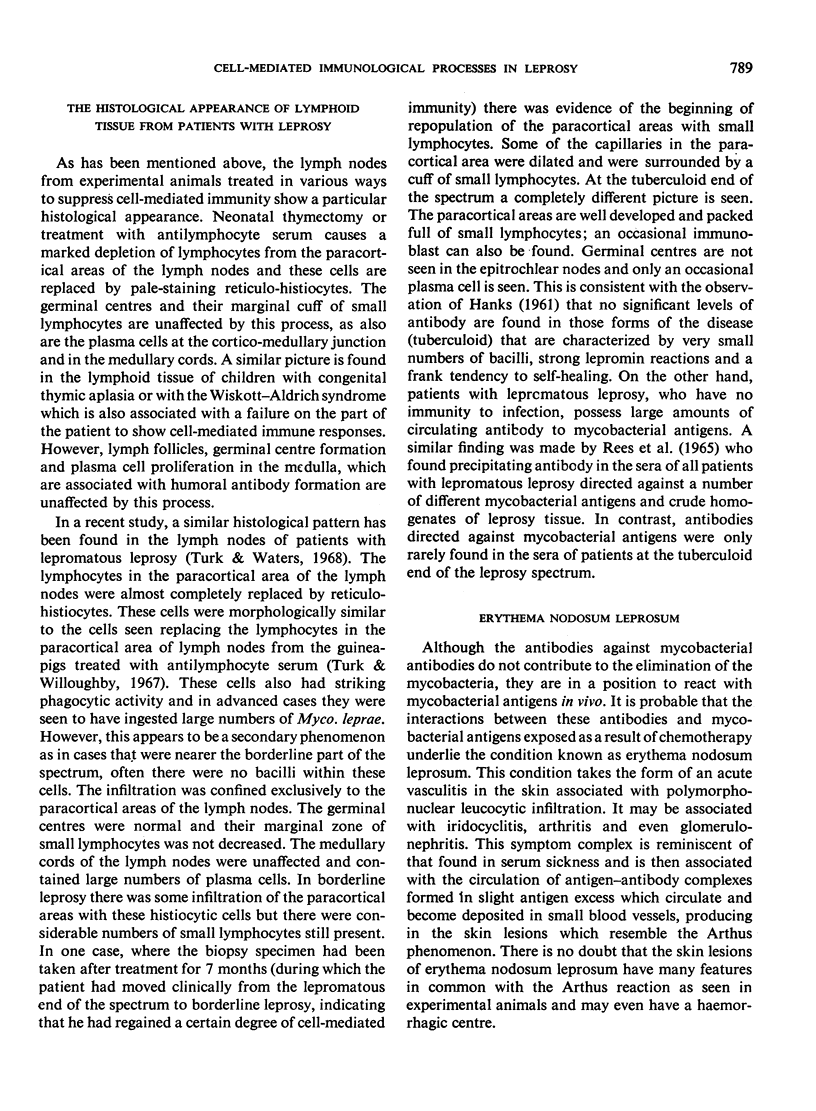
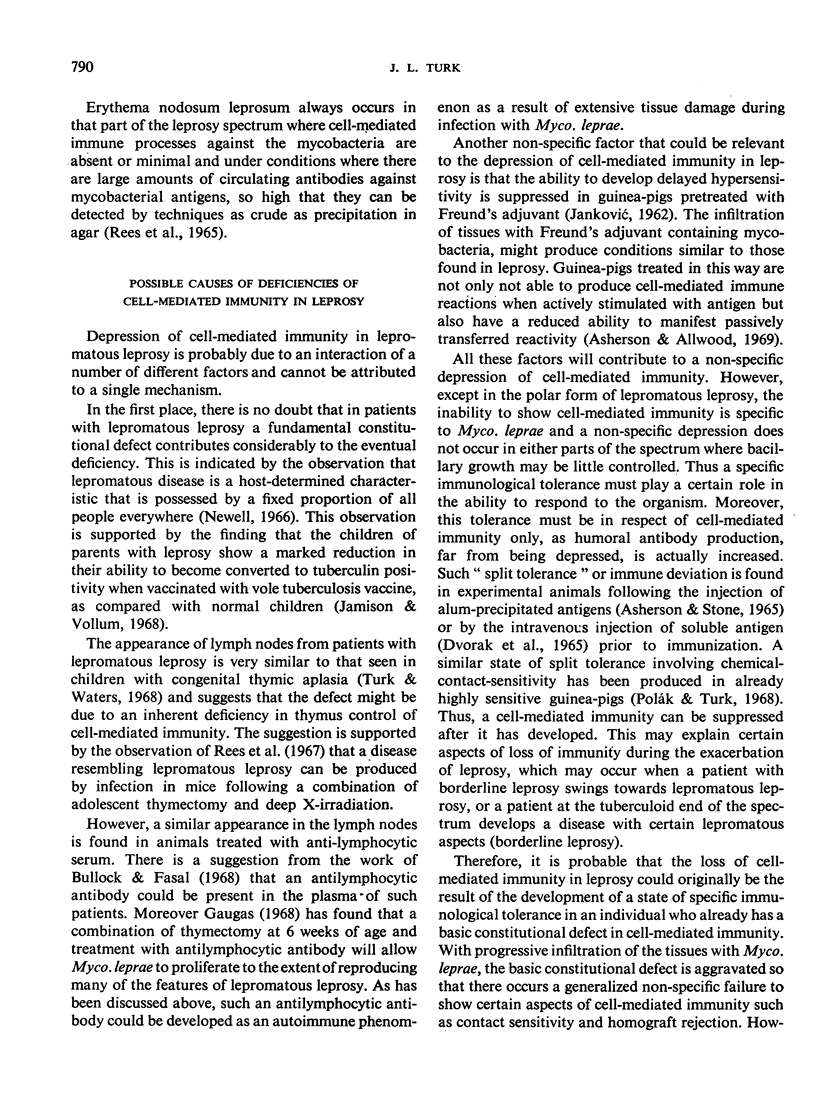
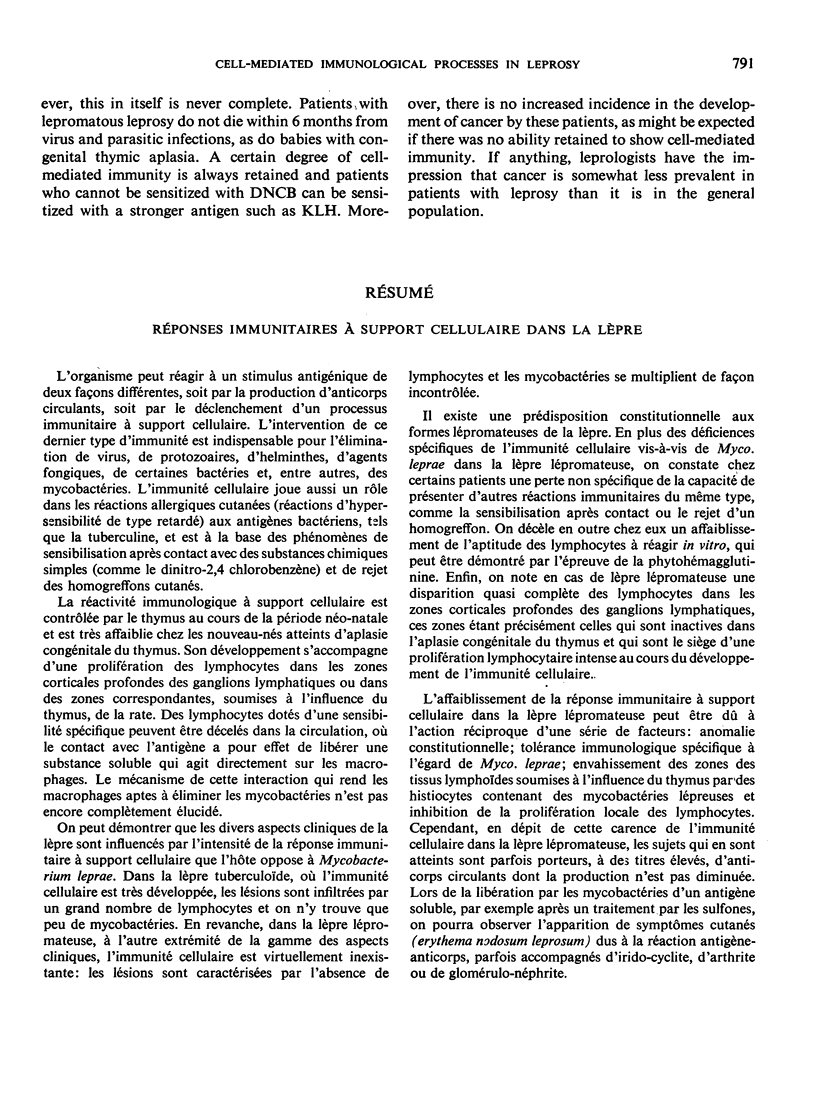
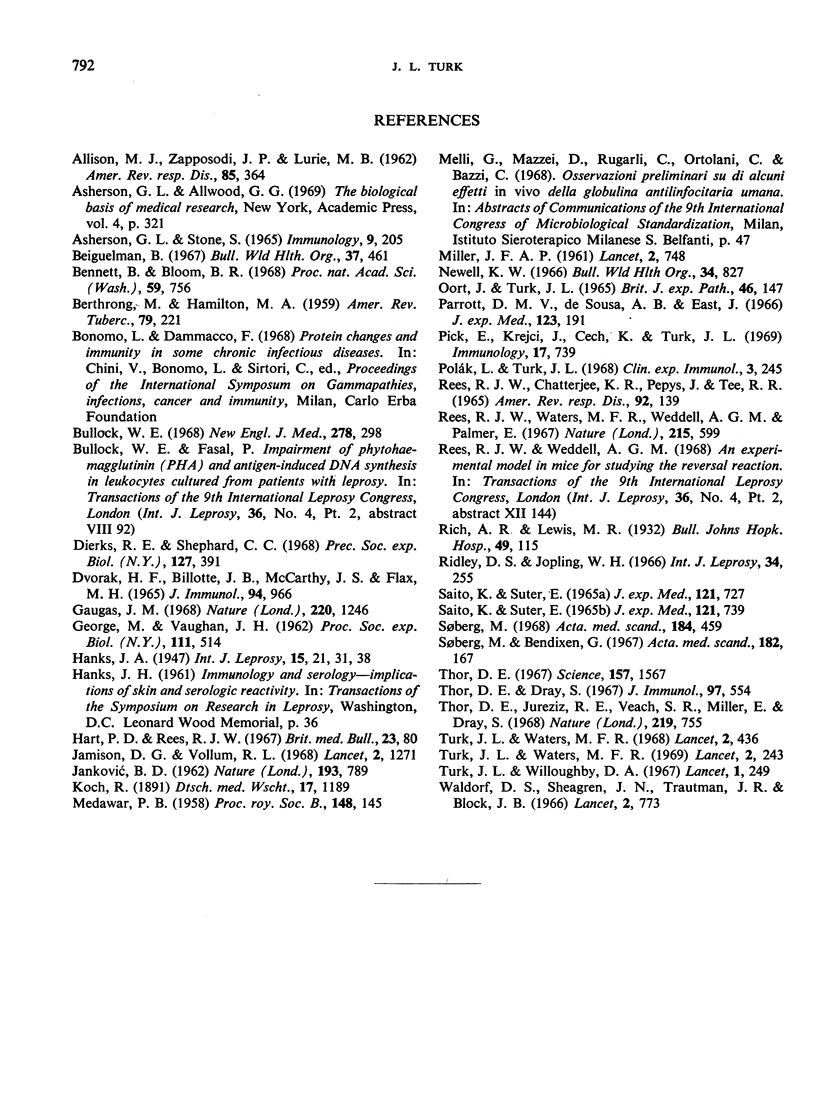
Selected References
These references are in PubMed. This may not be the complete list of references from this article.
- ALLISON M. J., ZAPPASODI P., LURIE M. B. Metabolic studies on mononuclear cells from rabbits of varying genetic resistance to tuberculosis. II. Studies on cells from BCG-vaccinated animals. Am Rev Respir Dis. 1962 Mar;85:364–372. doi: 10.1164/arrd.1962.85.3.364. [DOI] [PubMed] [Google Scholar]
- Asherson G. L., Stone S. H. Selective and specific inhibition of 24 hour skin reactions in the guinea-pig. I. Immune deviation: description of the phenomenon and the effect of splenectomy. Immunology. 1965 Sep;9(3):205–217. [PMC free article] [PubMed] [Google Scholar]
- BERTHRONG M., HAMILTON M. A. Tissue culture studies on resistance in tuberculosis. II. Monocytes from normal and immunized guinea pigs infected with virulent human tubercle bacilli. Am Rev Tuberc. 1959 Feb;79(2):221–231. doi: 10.1164/artpd.1959.79.2.221. [DOI] [PubMed] [Google Scholar]
- Beiguelman B. Leprosy and genetics. A review of past research with remarks concerning future investigations. Bull World Health Organ. 1967;37(3):461–476. [PMC free article] [PubMed] [Google Scholar]
- Bennett B., Bloom B. R. Reactions in vivo and in vitro produced by a soluble substance associated with delayed-type hypersensitivity. Proc Natl Acad Sci U S A. 1968 Mar;59(3):756–762. doi: 10.1073/pnas.59.3.756. [DOI] [PMC free article] [PubMed] [Google Scholar]
- DVORAK H. F., BILLOTE J. B., MCCARTHY J. S., FLAX M. H. IMMUNOLOGIC UNRESPONSIVENESS IN THE ADULT GUINEA PIG. I. SUPPRESSION OF DELAYED HYPERSENSITIVITY AND ANTIBODY FORMATION TO PROTEIN ANTIGENS. J Immunol. 1965 Jun;94:966–975. [PubMed] [Google Scholar]
- Dierks R. E., Shepard C. C. Effect of phytohemagglutinin and various mycobacterial antigens on lymphocyte cultures from leprosy patients. Proc Soc Exp Biol Med. 1968 Feb;127(2):391–395. doi: 10.3181/00379727-127-32698. [DOI] [PubMed] [Google Scholar]
- GEORGE M., VAUGHAN J. H. In vitro cell migration as a model for delayed hypersensitivity. Proc Soc Exp Biol Med. 1962 Nov;111:514–521. doi: 10.3181/00379727-111-27841. [DOI] [PubMed] [Google Scholar]
- Gaugas J. M. Enhancing effect of antilymphocytic globulin on human leprosy infection in thymectomized mice. Nature. 1968 Dec 21;220(5173):1246–1248. doi: 10.1038/2201246a0. [DOI] [PubMed] [Google Scholar]
- Hart P. D., Rees R. J. Lepromin and Kveim antigen reactivity in man, and their relation to tuberculin reactivity. Br Med Bull. 1967 Jan;23(1):80–85. doi: 10.1093/oxfordjournals.bmb.a070522. [DOI] [PubMed] [Google Scholar]
- JANKOVIC B. D. Impairment of immunological reactivity in guinea pigs by prior injection of adjuvant. Nature. 1962 Feb 24;193:789–790. doi: 10.1038/193789a0. [DOI] [PubMed] [Google Scholar]
- Jamison D. G., Vollum R. L. Tuberculin conversion in leprous families in Northern Nigeria. Lancet. 1968 Dec 14;2(7581):1271–1272. doi: 10.1016/s0140-6736(68)91763-7. [DOI] [PubMed] [Google Scholar]
- MEDAWAR P. B. The homograft reaction. Proc R Soc Lond B Biol Sci. 1958 Dec 4;149(935):145–166. doi: 10.1098/rspb.1958.0058. [DOI] [PubMed] [Google Scholar]
- MILLER J. F. Immunological function of the thymus. Lancet. 1961 Sep 30;2(7205):748–749. doi: 10.1016/s0140-6736(61)90693-6. [DOI] [PubMed] [Google Scholar]
- OORT J., TURK J. L. A HISTOLOGICAL AND AUTORADIOGRAPHIC STUDY OF LYMPH NODES DURING THE DEVELOPMENT OF CONTACT SENSITIVITY IN THE GUINEA-PIG. Br J Exp Pathol. 1965 Apr;46:147–154. [PMC free article] [PubMed] [Google Scholar]
- Parrott D. V., De Sousa M. A., East J. Thymus-dependent areas in the lymphoid organs of neonatally thymectomized mice. J Exp Med. 1966 Jan 1;123(1):191–204. doi: 10.1084/jem.123.1.191. [DOI] [PMC free article] [PubMed] [Google Scholar]
- Polák L., Turk J. L. Studies on the effect of systemic administration of sensitizers in guinea-pigs with contact sensitivity to inorganic metal compounds. I. The induction of immunological unresponsiveness in already sensitized animals. Clin Exp Immunol. 1968 Mar;3(3):245–251. [PMC free article] [PubMed] [Google Scholar]
- Rees R. J., Chatterjee K. R., Pepys J., Tee R. D. Some immunologic aspects of leprosy. Am Rev Respir Dis. 1965 Dec;92(6):139–149. doi: 10.1164/arrd.1965.92.6P2.139. [DOI] [PubMed] [Google Scholar]
- Rees R. J., Waters M. F., Weddell A. G., Palmer E. Experimental lepromatous leprosy. Nature. 1967 Aug 5;215(5101):599–602. doi: 10.1038/215599a0. [DOI] [PubMed] [Google Scholar]
- Ridley D. S., Jopling W. H. Classification of leprosy according to immunity. A five-group system. Int J Lepr Other Mycobact Dis. 1966 Jul-Sep;34(3):255–273. [PubMed] [Google Scholar]
- SAITO K., SUTER E. LYSOSOMAL ACID HYDROLASES AND HYPERREACTIVITY TO ENDOTOXIN IN MICE INFECTED WITH BCG. J Exp Med. 1965 May 1;121:739–749. doi: 10.1084/jem.121.5.739. [DOI] [PMC free article] [PubMed] [Google Scholar]
- SAITO K., SUTER E. LYSOSOMAL ACID HYDROLASES IN MICE INFECTED WITH BCG. J Exp Med. 1965 May 1;121:727–738. doi: 10.1084/jem.121.5.727. [DOI] [PMC free article] [PubMed] [Google Scholar]
- Soborg M. In vitro detection of cellular hypersensitivity in man. Specific migration inhibition of white blood cells from brucella-positive persons. Acta Med Scand. 1967 Aug;182(2):167–174. [PubMed] [Google Scholar]
- Soborg M. The development of cellular hypersensitivity in man after a primary immunization. Acta Med Scand. 1968 Nov;184(5):459–464. [PubMed] [Google Scholar]
- Thor D. E. Delayed hypersensitivity in man: a correlate in vitro and transfer by an RNA extract. Science. 1967 Sep 29;157(3796):1567–1569. doi: 10.1126/science.157.3796.1567. [DOI] [PubMed] [Google Scholar]
- Thor D. E., Jureziz R. E., Veach S. R., Miller E., Dray S. Cell migration inhibition factor released by antigen from human peripheral lymphocytes. Nature. 1968 Aug 17;219(5155):755–757. doi: 10.1038/219755a0. [DOI] [PubMed] [Google Scholar]
- Turk J. L., Waters M. F. Cell-mediated immunity in patients with leprosy. Lancet. 1969 Aug 2;2(7614):243–246. doi: 10.1016/s0140-6736(69)90009-9. [DOI] [PubMed] [Google Scholar]
- Turk J. L., Waters M. F. Immunological basis for depression of cellular immunity and the delayed allergic response in patients with lepromatous leprosy. Lancet. 1968 Aug 24;2(7565):436–438. doi: 10.1016/s0140-6736(68)90472-8. [DOI] [PubMed] [Google Scholar]
- Turk J. L., Willoughby D. A. Central and peripheral effects of anti-lymphocyte sera. Lancet. 1967 Feb 4;1(7484):249–251. doi: 10.1016/s0140-6736(67)91307-4. [DOI] [PubMed] [Google Scholar]
- Waldorf D. S., Sheagren J. N., Trautman J. R., Block J. B. Impaired delayed hypersensitivity in patients with lepromatous leprosy. Lancet. 1966 Oct 8;2(7467):773–776. doi: 10.1016/s0140-6736(66)90366-7. [DOI] [PubMed] [Google Scholar]


